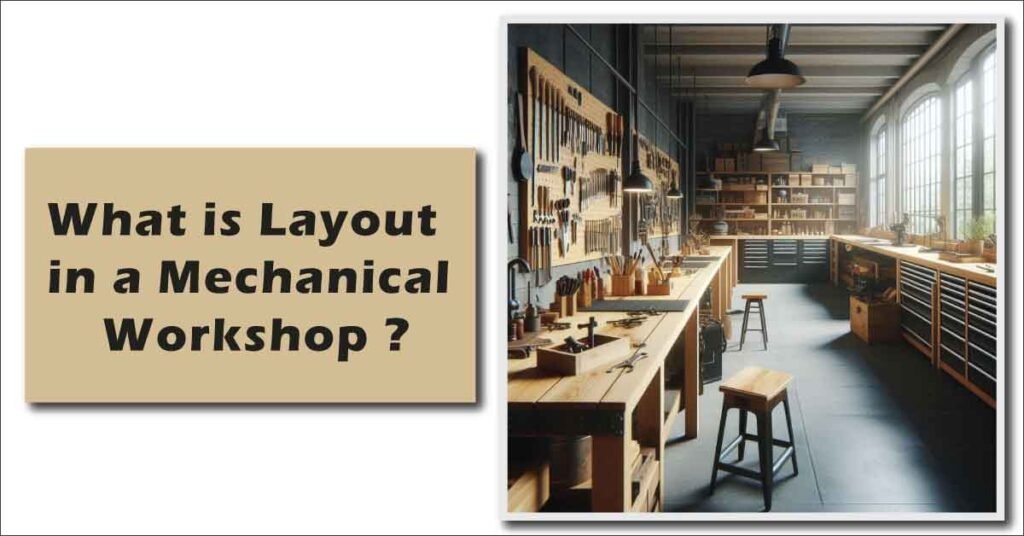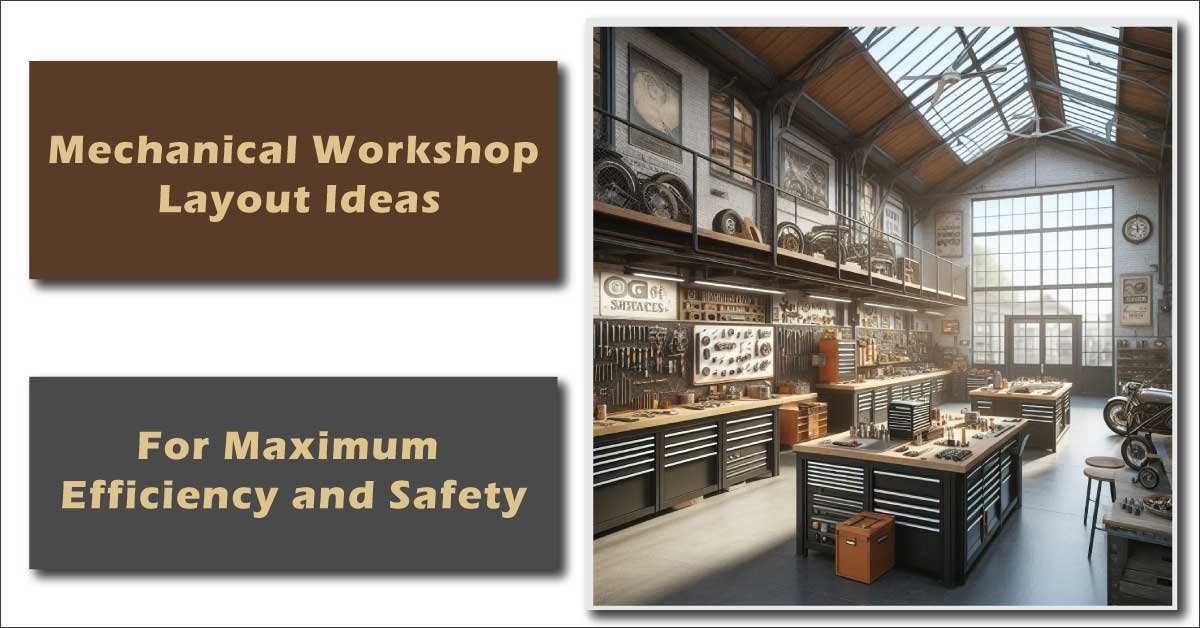To design an efficient mechanical workshop layout, consider factors like space, workflow, and equipment placement. Use vertical storage and zoning to maximize space. Place tools and machines logically to streamline movement and productivity. Ensure safety by incorporating clear pathways, ventilation, and emergency exits. Opt for modular furniture for flexibility and future-proofing. These simple mechanical workshop layout ideas can transform any space into a functional and safe work environment.
Mechanical Workshop Layout Ideas: How to Design the Perfect Workspace
Its an important aspect while undertaking mechanical work is to ensure that the environment in which the work is being done is proper. It will prove that no matter what the size of the outfit, whether running a small garage, or a full-scale mechanical workshop, having a good design can greatly influence the efficiency, safety and organization of the workshop. In this piece of article, we will discuss several mechanical workshop layout ideas that will allow you to maximize your space and improve your workshop productivity.
Why a Well-Designed Mechanical Workshop Layout is Essential
Layout design is much more than simply trying to wedge some equipment into a room. It is making the environment better suited for work and productiveness while at the same time considering safety standards. When it comes to mechanical workshop layout ideas it is important to avoid unnecessary movement and reduce the incidence of accidents and most importantly everybody knows where things are.
For instance, mechanics always moving from one end of the workshop to the other merely trying to get tools, time is wasted. An effective spatial design avoids such movements as much as possible resulting in increased efficiency of the workers in completing the jobs. At the same time, storage, ventilation, and lighting and safety exits are the factors which in combination with layout contribute to effective and safe operation.
Key Considerations When Planning Your Mechanical Workshop Layout
Before highlighting various mechanical workshop layout concepts, it will be useful to realize that there are certain factors that should be taken into account.
Available Space: Size of the workshop will determine so much about the design of the work shop. Take dimensions of the space and determine the sections where large equipment will be kept.
Workflow: Transitional movement from one task to another has to be effective. Think about how they are going to be distributed in a proven and sequential manner. For instance, car lifts should be conveniently located adjacent to storage of tools and bins containing spare parts.
Equipment Needs: It should be noted that every is unique when it comes to tools and equipment that are required in the course of their work. Tick the things that are important to design based on what one has and what may be required, in the layout.
Storage Solutions: Storage should be convenient but not in the way and this is because tools ought to be easily accessible while at the same time not becoming an eye sore. Some of the ways to minimize clutter include storage shelves, peg boards and tool chest.
Safety Considerations: Plan for wide aisles, emergency exits, and appropriate ventilation systems, especially when dealing with exhaust fumes or chemicals.
By focusing on these aspects, you can ensure that your mechanical workshop layout ideas meet both practical and safety needs.
How to Design a Mechanical Workshop?
Thus planning is a crucial factor in designing a mechanical workshop that will contain the mechanical workshop’s designs with much space, effectiveness and security. It will begin with the chance to measure the available area as well as analyse which kinds of work will be executed. Next, identify where crucial tools and equipment, including work bencks, stock rooms, and large equipment will be located.
Make sure that different areas are assigned to specific activities and this may include machining area, welding area and assembling area. Accommodation must include safety features; for example, clear paths, correct functioning of openings to the environment, and evacuation routes.
Make use of ergonomic equipment and matters like using appropriate furniture and proper lighting to minimize the levels strain. Mechanical workplaces are also subjected to the same problems since a good planned mechanical workshop should reduce work loss, increase productivity and efficiency.
Maximizing Space Efficiency in Mechanical Workshop Layouts
This is probably one of the most common issues of any workshop; the best way to manage space. It should also be said that even in great shops that provides numerous square meters of working space, a bad layout can certainly create the impression of cluttered and overcrowded workplace. Here are some mechanical workshop layout ideas to maximize space efficiency:Here are some mechanical workshop layout ideas to maximize space efficiency:
Vertical Storage: Maximize the wall space by incorporating shelves or pegboards put in tool or component storage. This makes the area free from clutter and all can be found in one place as may be required at times.
Zoning: Categorize the layout of the workshop into sections that are distinct and include zones for things like power tools, switch gears, manufacturing and overhaul respectively. This organization can eliminate the accumulation of items and a confusing and cluttered working environment.
Multipurpose Benches: Choose workbenches that have shelves below so that you can store materials and tools there. It enables you to have several tools and equipment within reach and yet not compromise the needed cleanliness.
Using these ideas on mechanical workshop layout, you’ll be able to maintain your workplace efficient and neat irrespective of how limited the space is.

What is Layout in a Mechanical Workshop?
In a mechanical workplace format means the position of the machines, tools, working platforms and materials in Mechanical workshop. A good layout is meant to achieve an organizational goal that work be done in an orderly manner and with as little movement between tasks as possible. It arranges the tools and equipments in a way that the most used equipment are easily accessible, it has enough working space for the technicians and the materials can be easily accessed.
Layout planning also pays attention to safety measures, storage systems and facilities, and ease of maintenance among others so as to reduce confusion, minimize time spent in search of tools among other things when working in the Workshop.
Mechanical Workshop Layout Ideas for Small Spaces
Many mechanical workshops are set up in smaller spaces, such as home garages. In these cases, clever design is key to creating a fully functional workshop. Here are some mechanical workshop layout ideas tailored for smaller spaces:
Foldable Workbenches: A foldable workbench can be a game changer in a small workshop. It provides a solid work surface when needed but can be tucked away to free up space.
Tool Walls: Install a pegboard on the wall to hang your most-used tools. This eliminates the need for bulky toolboxes on the floor.
Compact Storage: Use stackable storage containers or a rolling tool chest. These allow you to store equipment in an organized way without taking up too much floor space.
By applying these mechanical workshop layout ideas, even small spaces can be transformed into efficient, organized workshops.

What is a Good Workshop Layout?
A good location of a workshop is one that should enhance the flow of work, accident-free and good utilization of space. It should be divided into distinct zones for distinct activities like machining, assembly or repair as this would help eliminate confusion and the related crossflow of activities. Tools such as dials, levers or switches should also be kept in a relevant place so that it is rarely required to retrieve material or technicians.
More on the tool and part storage requirement, tools and parts must be stored properly and all the frequently used equipments must be easily accessible. Also, it should provide safety factors such as natural light and air for the working space and existence of escape routes in the plan. Further, flexibility of layout also means a capacity for future development and modifications of equipment.
Learn about essential mechanical maintenance practices to keep your equipment in top condition. Discover tips for effective upkeep and troubleshooting. Read the full post for comprehensive maintenance strategies!
Optimizing Workflow with Your Mechanical Workshop Layout
It is fundamental to increase the efficiency of workflow in any well organized workshop. Work flow means that a mechanic does not have to spend time struggling to go from one task to another because there is a plan that guides him. Here’s how to apply mechanical workshop layout ideas to improve workflow:Here’s how to apply mechanical workshop layout ideas to improve workflow:
Logical Equipment Placement: Most of the items should be placed close to the areas that are used mostly for operating the related equipment and utensils. Ie if you have a car- lift, ideally, your wrenches, jacks and diagnostic instruments should be easily accessible here. This saves that frequent practicing of walking across the workshop for some basic items.
Clear Pathways: Make certain that the aisle issues are adequately taken care of in order to allow adequate movement through the aisles. This comes in handy especially where a part or tool will be transferred to another region in the workshop.
Dedicated Zones: The separate zones can be created in the workshop depending on the kind of work performed in the given area. For example, organize it in such a manner that one section deals with repairs, another with assembling of new products and a third for diagnosis. This helps in avoiding crowed that otherwise disturb the views and enable the formulation of better strategies.
Essential Tools and Equipment Placement in a Mechanical Workshop Layout
Therefore, it is clear that the arrangement for the mechanical workshop layout ideas should include a careful positioning of the tools and equipment. In a logical way, placing of tools enables a client to work more effectively and safely since they are safely and neatly arranged. Here are some tips for tool placement:Here are some tips for tool placement:
Tool Walls: Hanging frequently used tools on a wall near the workbench makes them easy to reach.
Mobile Tool Carts: For workshops with limited space, a mobile tool cart can be used to move tools to different areas as needed.
Dedicated Storage: Large equipment such as air compressors and tire changers should have dedicated spots away from walkways but still within easy reach of the work area.
By organizing tools and equipment this way, you’ll streamline your operations and keep the workshop clutter-free.
Explore the essential mechanical tools and their uses to enhance your workshop’s efficiency. Discover how proper tool selection can streamline tasks and boost productivity. Read the full post for detailed insights!
What Are the Three Types of Workshop Layout?
The three common types of workshop layout are:
Process Layout: This is due to the reason that dependent on the process that the machine or equipment is used in, it would be grouped accordingly. (e.g., all lathes in one area, all milling machines in another). This layout is suitable for workshops that handle a wide variety of tasks and require flexibility.
Product Layout: Machines are arranged in a sequence based on the production process. This is ideal for workshops focused on producing a specific product or performing repetitive tasks in a streamlined manner.
Fixed-Position Layout: The product or workpiece remains in one location while technicians and equipment move to it. This layout is used for large projects like heavy machinery assembly, where moving the product is impractical.
Each layout has its advantages, depending on the type of work performed in the mechanical workshop.
Safety First: Designing a Safe Mechanical Workshop Layout
Safety should be a top priority in any mechanical workshop. Here are some mechanical workshop layout ideas that promote safety:
Clear Emergency Exits: Ensure that exits are easily accessible and free of obstructions. Mark them clearly and check them regularly.
Proper Ventilation: If your workshop involves welding, painting, or working with chemicals, good ventilation is crucial. Install exhaust fans or ventilation systems to remove harmful fumes.
Safety Zones: Dedicate space for safety gear such as fire extinguishers, first-aid kits, and protective equipment. Make sure these areas are clearly marked and easily accessible.
By integrating these safety considerations into your mechanical workshop layout, you create a safer environment for yourself and your team.
Future-Proofing Your Mechanical Workshop Layout Ideas
Your needs today may not be the same in the future. That’s why it’s important to future-proof your mechanical workshop layout ideas. Here are some strategies:
Modular Design: Create a layout that can be easily adjusted or expanded. Use modular furniture or tool storage that can be moved or reconfigured.
Allow for Expansion: If possible, leave space for future equipment or additional workstations. Planning for growth now will save you the headache of reconfiguring everything later.
Flexible Workstations: Consider setting up workstations that can be used for multiple purposes. For example, a bench that works for both assembly and repairs can be helpful as needs change.
Future-proofing ensures that your workshop remains functional and relevant, no matter how your business evolves.
Conclusion: Bringing Your Mechanical Workshop Layout Ideas to Life
Incorporating thoughtful mechanical workshop layout ideas can transform any space into a highly productive and safe working environment. From maximize the space efficiency to optimized the workflow and ensured safety, every detail matters when design the workshop. Whether you are working in the small garage or a large facility, these ideas will help you create a well-organized, future-proof mechanical workshop layout that meets your needs today and tomorrow.
Discover top software for mechanical engineering, from design to simulation. Learn about essential tools that streamline your workflow and improve project outcomes. Read the full post for detailed recommendations!

